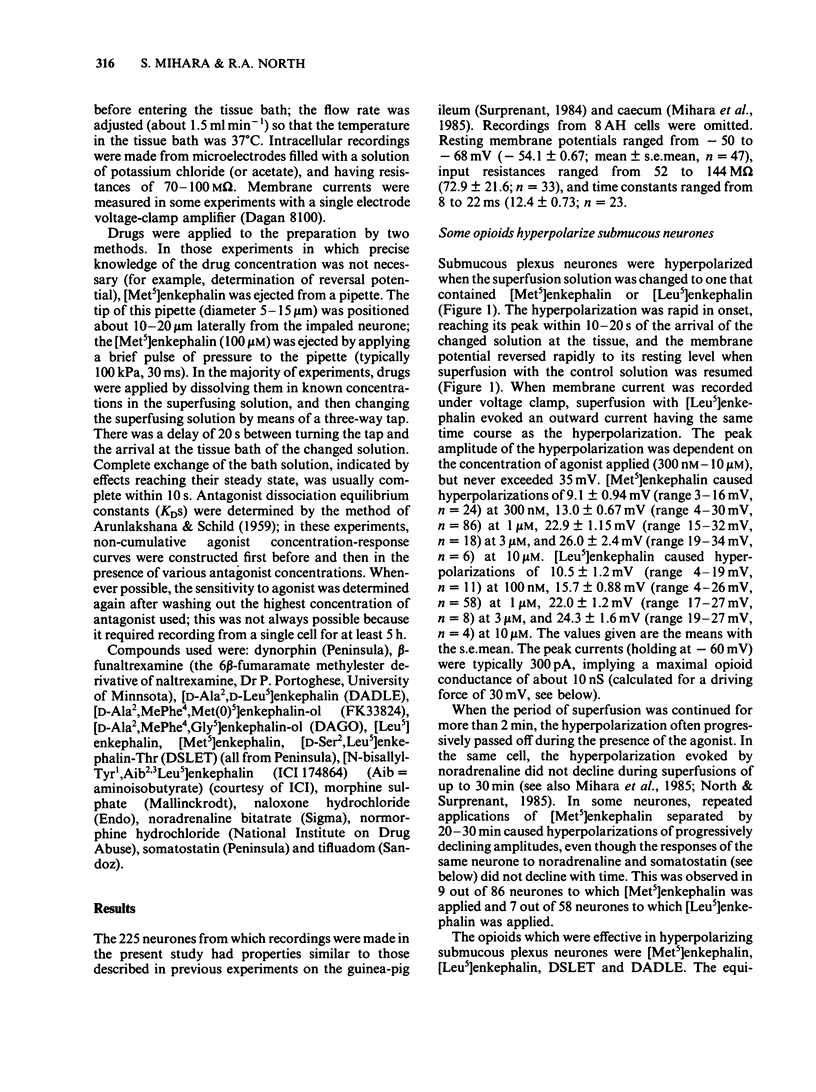Abstract
Intracellular records were made from neurones in the submucous plexus of the guinea-pig caecum. [Met5]enkephalin, [Leu5]enkephalin, [D-Ala2,D-Leu5]enkephalin (DADLE) and [D-Ser2,Leu5]enkephalin-Thr (DSLET) hyperpolarized the membrane when applied in concentrations of 30 nm-10 microM. Normorphine, [D-Ala2, MePhe4,Gly5]enkephalin-ol (DAGO), [D-Ala2,MePhe4,Met(0)5]enkephalin-ol (FK33824), dynorphin A and tifluadom had no effect at concentrations up to 10 microM. The hyperpolarization resulted from an increase in the membrane potassium conductance. Hyperpolarizations induced by [Met5]enkephalin were antagonized competitively by naloxone and by N-bisallyl[aminoisobutyrate2,3, Leu5]enkephalin (ICI 174864). The Schild plots for these antagonisms had slopes not different from one, and the dissociation equilibrium constants among individual neurones were 5-50 nM for naloxone and 5-60 nM for ICI 174864. The results indicate that the opioid receptors on guinea-pig submucous neurones which are coupled to potassium channels are of the delta-type.
Full text
PDF







Selected References
These references are in PubMed. This may not be the complete list of references from this article.
- ARUNLAKSHANA O., SCHILD H. O. Some quantitative uses of drug antagonists. Br J Pharmacol Chemother. 1959 Mar;14(1):48–58. doi: 10.1111/j.1476-5381.1959.tb00928.x. [DOI] [PMC free article] [PubMed] [Google Scholar]
- Akil H., Watson S. J., Young E., Lewis M. E., Khachaturian H., Walker J. M. Endogenous opioids: biology and function. Annu Rev Neurosci. 1984;7:223–255. doi: 10.1146/annurev.ne.07.030184.001255. [DOI] [PubMed] [Google Scholar]
- Binder H. J., Laurenson J. P., Dobbins J. W. Role of opiate receptors in regulation of enkephalin stimulation of active sodium and chloride absorption. Am J Physiol. 1984 Oct;247(4 Pt 1):G432–G436. doi: 10.1152/ajpgi.1984.247.4.G432. [DOI] [PubMed] [Google Scholar]
- Cherubini E., North R. A. Mu and kappa opioids inhibit transmitter release by different mechanisms. Proc Natl Acad Sci U S A. 1985 Mar;82(6):1860–1863. doi: 10.1073/pnas.82.6.1860. [DOI] [PMC free article] [PubMed] [Google Scholar]
- Cotton R., Giles M. G., Miller L., Shaw J. S., Timms D. ICI 174864: a highly selective antagonist for the opioid delta-receptor. Eur J Pharmacol. 1984 Jan 27;97(3-4):331–332. doi: 10.1016/0014-2999(84)90470-9. [DOI] [PubMed] [Google Scholar]
- Duggan A. W., North R. A. Electrophysiology of opioids. Pharmacol Rev. 1983 Dec;35(4):219–281. [PubMed] [Google Scholar]
- Kachur J. F., Miller R. J., Field M. Control of guinea pig intestinal electrolyte secretion by a delta-opiate receptor. Proc Natl Acad Sci U S A. 1980 May;77(5):2753–2756. doi: 10.1073/pnas.77.5.2753. [DOI] [PMC free article] [PubMed] [Google Scholar]
- Lord J. A., Waterfield A. A., Hughes J., Kosterlitz H. W. Endogenous opioid peptides: multiple agonists and receptors. Nature. 1977 Jun 9;267(5611):495–499. doi: 10.1038/267495a0. [DOI] [PubMed] [Google Scholar]
- North R. A., Surprenant A. Inhibitory synaptic potentials resulting from alpha 2-adrenoceptor activation in guinea-pig submucous plexus neurones. J Physiol. 1985 Jan;358:17–33. doi: 10.1113/jphysiol.1985.sp015537. [DOI] [PMC free article] [PubMed] [Google Scholar]
- North R. A., Williams J. T. On the potassium conductance increased by opioids in rat locus coeruleus neurones. J Physiol. 1985 Jul;364:265–280. doi: 10.1113/jphysiol.1985.sp015743. [DOI] [PMC free article] [PubMed] [Google Scholar]
- Paterson S. J., Robson L. E., Kosterlitz H. W. Classification of opioid receptors. Br Med Bull. 1983 Jan;39(1):31–36. doi: 10.1093/oxfordjournals.bmb.a071787. [DOI] [PubMed] [Google Scholar]
- Surprenant A., North R. A. mu-Opioid receptors and alpha 2-adrenoceptors coexist on myenteric but not on submucous neurones. Neuroscience. 1985 Oct;16(2):425–430. doi: 10.1016/0306-4522(85)90014-4. [DOI] [PubMed] [Google Scholar]
- Ward S. J., Portoghese P. S., Takemori A. E. Pharmacological profiles of beta-funaltrexamine (beta-FNA) and beta-chlornaltrexamine (beta-CNA) on the mouse vas deferens preparation. Eur J Pharmacol. 1982 Jun 4;80(4):377–384. doi: 10.1016/0014-2999(82)90083-8. [DOI] [PubMed] [Google Scholar]
- Werz M. A., MacDonald R. L. Opioid peptides selective for mu- and delta-opiate receptors reduce calcium-dependent action potential duration by increasing potassium conductance. Neurosci Lett. 1983 Dec 2;42(2):173–178. doi: 10.1016/0304-3940(83)90402-0. [DOI] [PubMed] [Google Scholar]
- Werz M. A., Macdonald R. L. Dynorphin reduces calcium-dependent action potential duration by decreasing voltage-dependent calcium conductance. Neurosci Lett. 1984 May 4;46(2):185–190. doi: 10.1016/0304-3940(84)90439-7. [DOI] [PubMed] [Google Scholar]
- Werz M. A., Macdonald R. L. Dynorphin reduces voltage-dependent calcium conductance of mouse dorsal root ganglion neurons. Neuropeptides. 1984 Dec;5(1-3):253–256. doi: 10.1016/0143-4179(84)90075-1. [DOI] [PubMed] [Google Scholar]
- Werz M. A., Macdonald R. L. Opioid peptides with differential affinity for mu and delta receptors decrease sensory neuron calcium-dependent action potentials. J Pharmacol Exp Ther. 1983 Nov;227(2):394–402. [PubMed] [Google Scholar]
- Williams J. T., North R. A. Opiate-receptor interactions on single locus coeruleus neurones. Mol Pharmacol. 1984 Nov;26(3):489–497. [PubMed] [Google Scholar]


